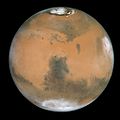Fitxer:Mars and Syrtis Major - GPN-2000-000923.jpg
Aparença

Mida d'aquesta previsualització: 600 × 600 píxels. Altres resolucions: 240 × 240 píxels | 480 × 480 píxels | 1.023 × 1.023 píxels.
Fitxer original (1.023 × 1.023 píxels, mida del fitxer: 104 Ko, tipus MIME: image/jpeg)
Historial del fitxer
Cliqueu una data/hora per veure el fitxer tal com era aleshores.
| Data/hora | Miniatura | Dimensions | Usuari/a | Comentari | |
|---|---|---|---|---|---|
| actual | 23:57, 17 juny 2012 |  | 1.023 × 1.023 (104 Ko) | Tomruen | {{Information |Description ={{en|1=Mars Near Opposition 1995-2005: 1999 }} |Source =Replace with 2005 release: http://hubblesite.org/newscenter/archive/releases/solar%20system/mars/2005/34/image/h/ |Author =NASA |Date =2005... |
| 01:52, 9 abr 2009 |  | 800 × 800 (227 Ko) | BotMultichillT | {{Information |Description={{en|1=Taking advantage of Mars's closest approach to Earth in eight years, astronomers using NASA's Hubble Space Telescope have taken the space-based observatory's sharpest views yet of the Red Planet. The telescope's Wide Fi |
Ús del fitxer
La pàgina següent utilitza aquest fitxer:
Ús global del fitxer
Utilització d'aquest fitxer en altres wikis:
- Utilització a ar.wikipedia.org
- Utilització a en.wikipedia.org
- Portal:Technology/Selected articles
- Portal:Technology/Selected articles/38
- History of Mars observation
- Portal:Outer space/Selected article
- Glossary of astronomy
- Portal:Outer space/Selected article/31
- Wikipedia:Today's featured article/January 2013
- Wikipedia:Today's featured article/January 8, 2013
- Wikipedia:Main Page history/2013 January 8
- Utilització a es.wikipedia.org
- Utilització a fi.wikipedia.org
- Utilització a fr.wikipedia.org
- Utilització a he.wikipedia.org
- Utilització a id.wikipedia.org
- Utilització a ja.wikipedia.org
- Utilització a mwl.wikipedia.org
- Utilització a os.wikipedia.org
- Utilització a pt.wikipedia.org
- Utilització a ru.wikipedia.org
- Utilització a uk.wikipedia.org
- Utilització a ur.wikipedia.org
- Utilització a zh.wikipedia.org



